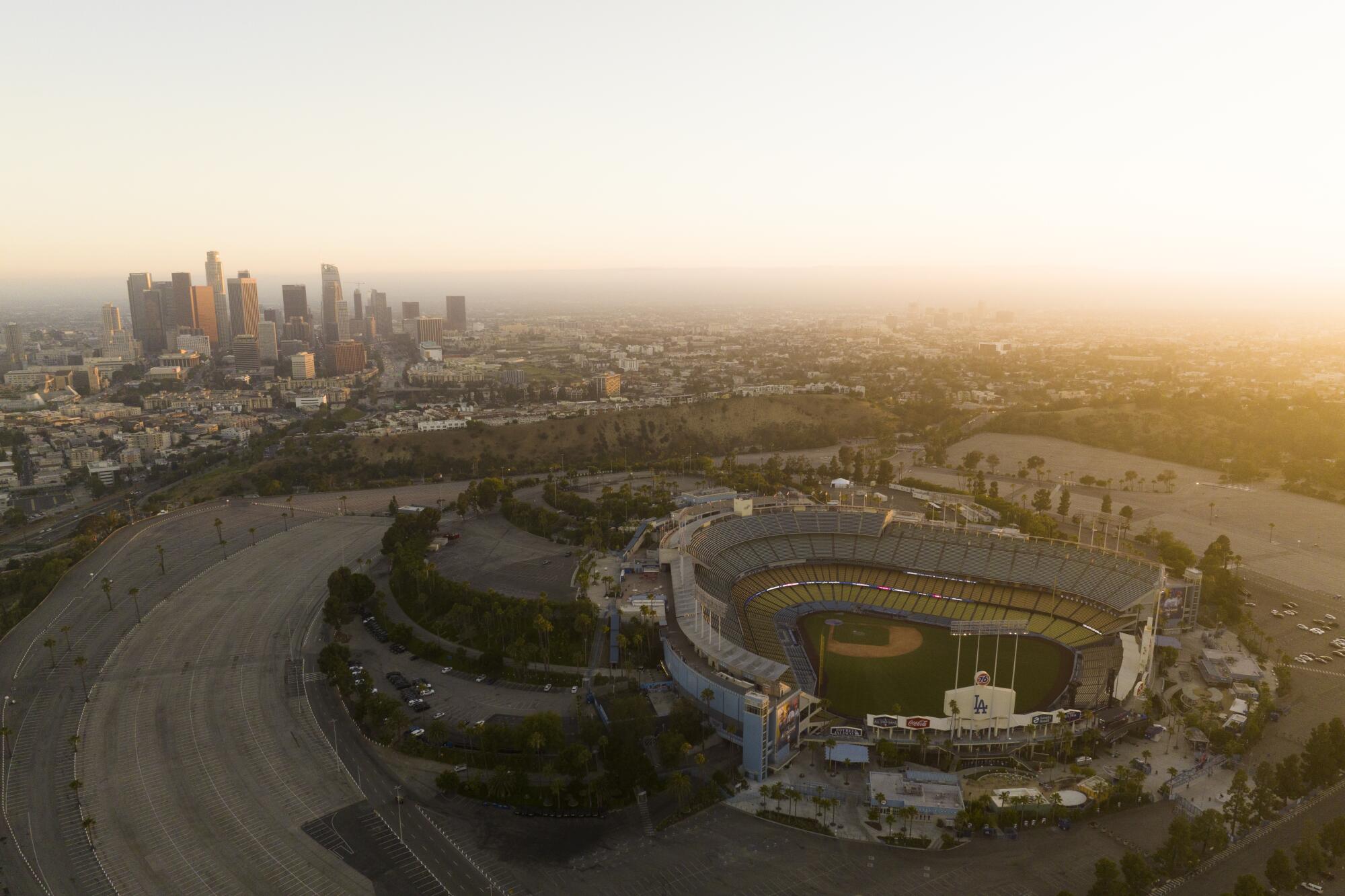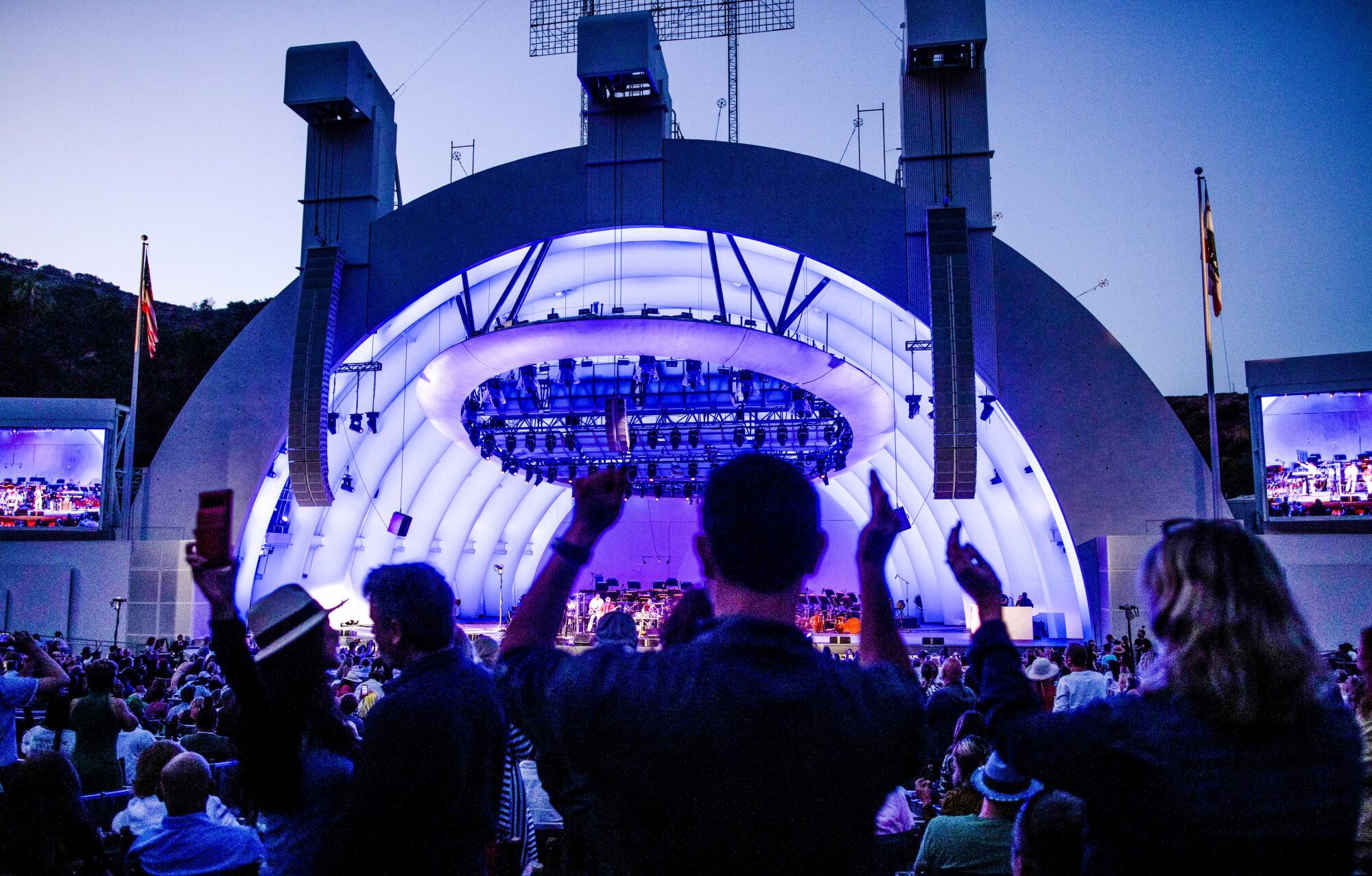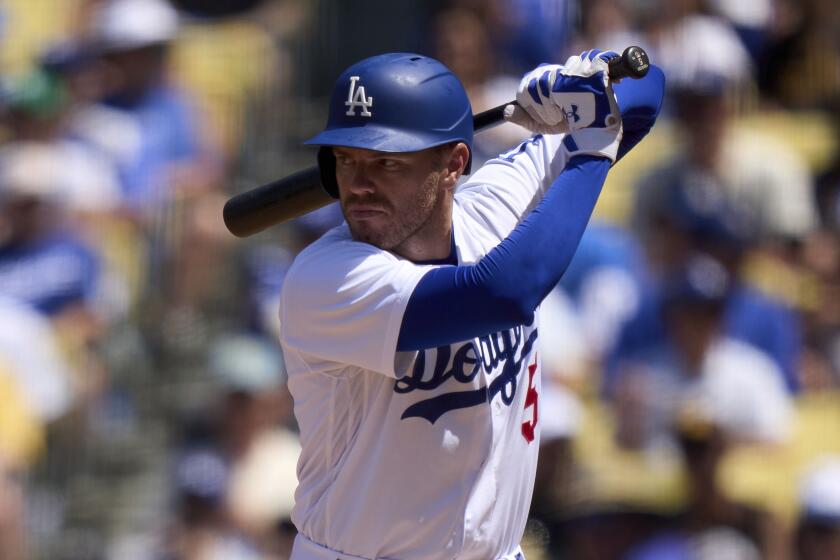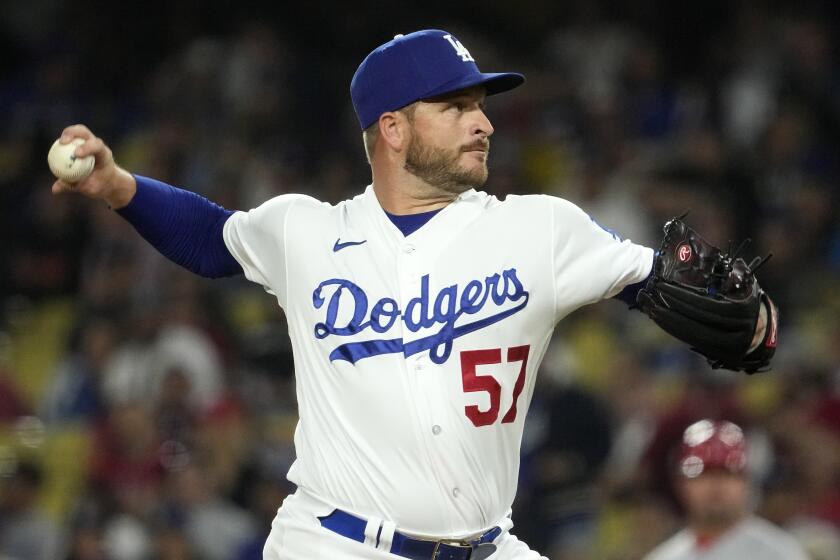(Los Angeles Times photo illustration; photos by Times staff, Adobe Stock)
- Share via
The bus doors opened, and the happy passengers scampered toward Dodger Stadium. The bus had come directly from their neighborhood.
The Dodgers offered a free team magazine to everyone as they exited. The entrance gate was a few steps away, leading directly to the food, drinks and attractions behind center field.
“We get to come here without worrying about parking,” rider Leslie Mendoza said. “It beats driving.”
The playoffs open Saturday at Dodger Stadium. With them come sellout crowds, and the notorious congestion into and within the stadium parking lots.
When it came to driving in runs with two outs, no one was better in the regular season than the Dodgers.
You can take a shuttle bus from Union Station to Dodger Stadium. You might be able to take a gondola to the stadium someday, but that also would require you to get to Union Station.
In Los Angeles, summer means Dodger Stadium and the Hollywood Bowl. For half a century, the Hollywood Bowl has offered park-and-ride buses, directly from your neighborhood, with dropoff at the front gate, and no need for a transfer at Union Station, or anywhere else.
The park-and-ride program is convenient, efficient, and popular. So why don’t the Dodgers offer park-and-ride buses?
“We have looked into it,” Dodgers President Stan Kasten said.
Kasten said the team has no plans to implement a park-and-ride program at this time, citing two challenges in particular.
For one, he said, the Dodgers might struggle to find enough large parking lots to accommodate demand. The Hollywood Bowl buses transported 295,467 riders last year, according to spokeswoman Sophie Jefferies, or 24% of the season audience.
The shuttles from Union Station to Dodger Stadium accommodated 214,038 riders last year, Metro spokesman Jose Ubaldo said, or 5% of the season audience.
If 24% of fans took a park-and-ride bus — the same as the Hollywood Bowl percentage — the Dodgers would need to secure parking spaces around town for about 1 million fans over the course of a season.
“And the buses also have to go through traffic,” Kasten said. “We wouldn’t have dedicated lanes all over town.”

The shuttle from Union Station speeds to Dodger Stadium along a dedicated (bus-only) lane along Sunset Boulevard. Turner Engineering Corp. of Venice, however, recently pitched Metro on a plan that could deploy technology to turn regular traffic lanes into speedy bus lanes and back again.
As Metro continues to add electric buses — its goal is to operate a zero-emission fleet by 2030 — those buses could be outfitted with existing technology that would turn a red light green as the bus approaches, or keep a green light green until the bus passes.
The buses could be used for regular service during the day and park-and-ride service to such jam-packed events as the 2026 World Cup, 2028 Olympic Games and any future Taylor Swift concerts.
“We think it’s great for Dodger Stadium,” said David Turner, president of Turner Engineering.
Turner said parking lots at shopping malls — whether the mall is still in use or mothballed — could provide neighborhood parking and pickup spots for park-and-ride buses. The Hollywood Bowl park-and-ride buses depart from 15 locations across Los Angeles County, including transit centers, shopping centers, recreation centers, and colleges.
Ubaldo, the Metro spokesman, said his agency believes large Metro parking lots around the county — at stations in such locations as El Monte, Gardena and North Hollywood — enable fans to park near home and catch public transit to Dodger Stadium, even with a stop at Union Station.
“We have many park-and-ride opportunities already,” Ubaldo said.
For many fans, the decision about how to get to Dodger Stadium could come down to time. On a weeknight, from the Westside, the drive regularly takes more than an hour.
Metro says the Westside subway — formerly called the Purple Line, now called the D Line, and scheduled for completion in 2027 — could get you from Brentwood to Union Station in 30 minutes.
Transfer from there to the shuttle, and the total trip could take 45 minutes to an hour, maybe a little more at peak demand. Transfer from there to the proposed gondola, and the projected total travel time would be close to 40 minutes.
Under his proposal, Turner says, park-and-ride buses could get from the Westside to Dodger Stadium in a little more than 30 minutes, with no stop at Union Station.

Money matters, of course. Metro contributes more than $1 million per year to the Hollywood Bowl park-and-ride program, Ubaldo said. Riders pay $7 in advance, $12 on the day of a show.
Yet the L.A. Philharmonic, which manages the county-owned Bowl, and the promoters that stage concerts there combine to cover about two-thirds of the park-and-ride costs, said Jefferies, the Bowl spokeswoman.
The Dodgers might be unlikely to subsidize a park-and-ride program. The Hollywood Bowl lacks ample parking and desperately needs its park-and-ride program. Dodger Stadium has about as many parking spaces as the Hollywood Bowl has seats.
“With all of our problems,” Kasten said, “we manage a very large number [of cars] reasonably efficiently, for the number that it is. It’s a huge number.
“Nowhere else needs that many cars. It’s a challenge. It’s never going to be perfect.”
Nothing is, except Sandy Koufax in 1965. But Metro and the Dodgers ought to work together to evaluate the feasibility of a park-and-ride system, offering another transit option for fans of a team that sells close to 4 million tickets every year. In our sprawling region, even an expanded Metro system is not a practical choice for all.
The Dodgers had one of the worst relief corps in the major leagues, but the group has been as good as anybody in the last three months.
In fact, there is one park-and-ride option already. It’s the bus described at the top of this column, the little-known alternate route for the Dodger Stadium Express shuttle buses. This route departs not from Union Station but from the Harbor Gateway Transit Center in Gardena, and it goes straight to the stadium.
That route serves about 700 fans per game, Ubaldo said. And, just like the shuttle from Union Station, this one costs nothing if you show a game ticket. Metro pays for the Dodger Stadium shuttles with revenues from grants, taxes and ads.
Jose Morales was all smiles as he got off the bus on one recent night, surveying the crowded parking lots all around him.
“I’m not paying 30 bucks,” he said. “I’d rather come here for free.”
Take me out to the ball game?
How would you prefer to get to Dodger Stadium? Vote in this survey and let us know.
More to Read
Are you a true-blue fan?
Get our Dodgers Dugout newsletter for insights, news and much more.
You may occasionally receive promotional content from the Los Angeles Times.













